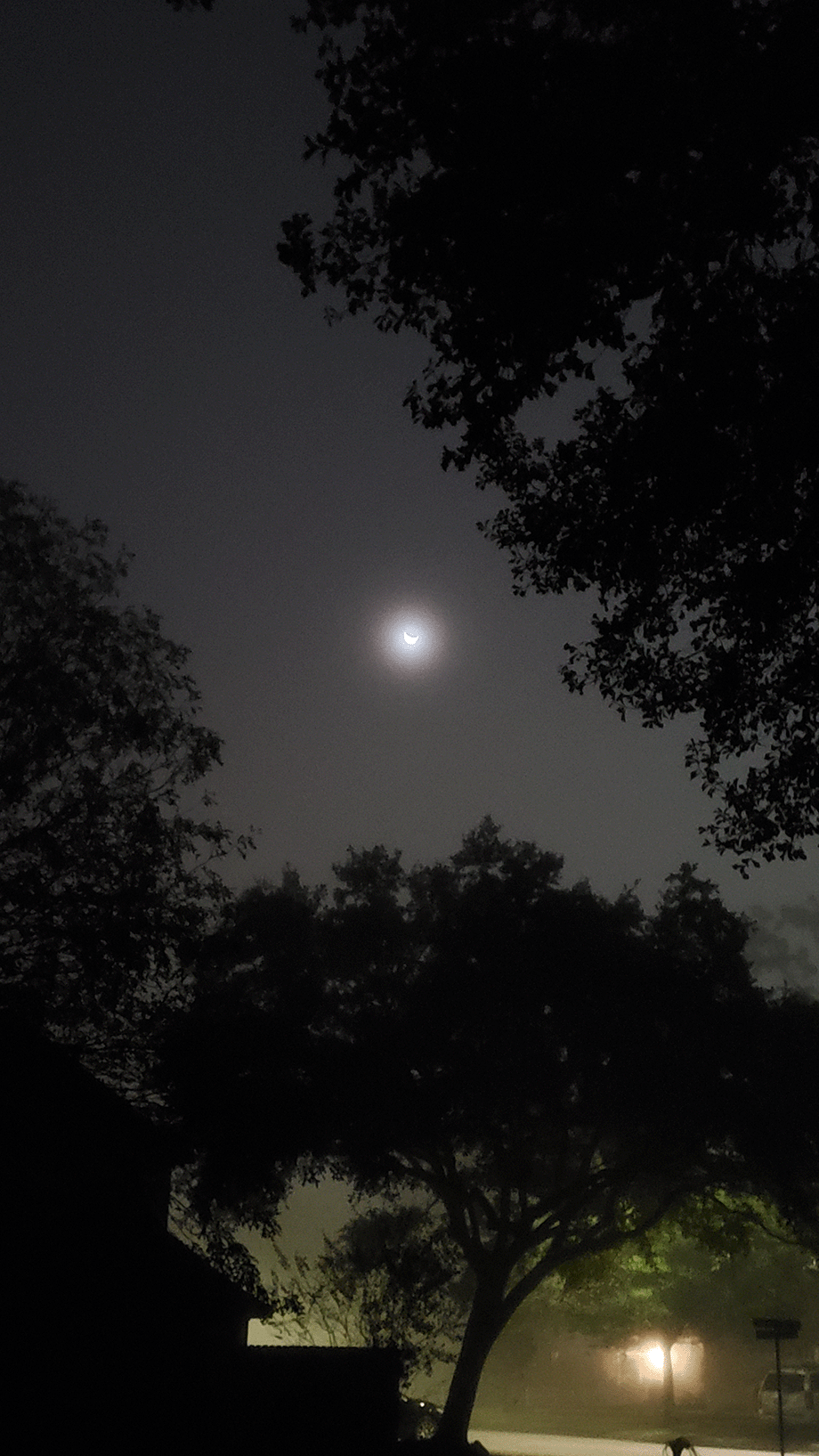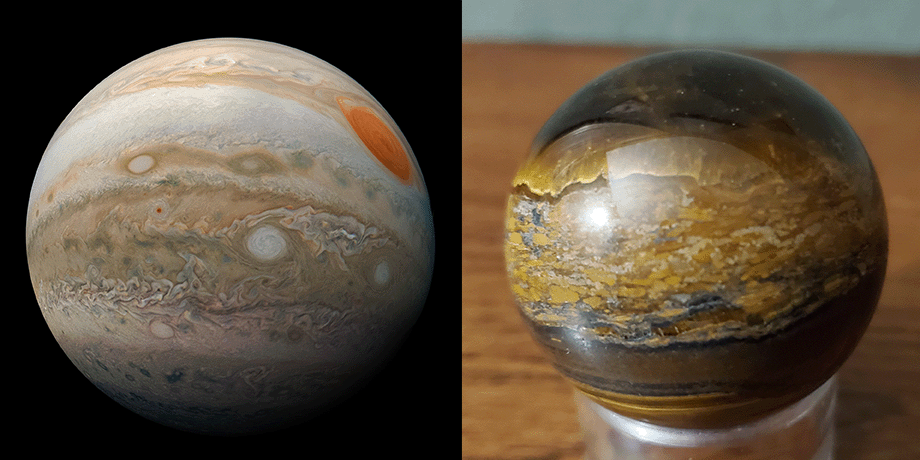This week brings us to the card numbered VII, in the eight position in the deck, the Chariot. Happily this image seems to be as overtly pagan as it’s immediate predecessor is Judaic in iconography. The card is literally dripping with esoteric symbols which can lead us down any number of rabbit holes in interpretation.
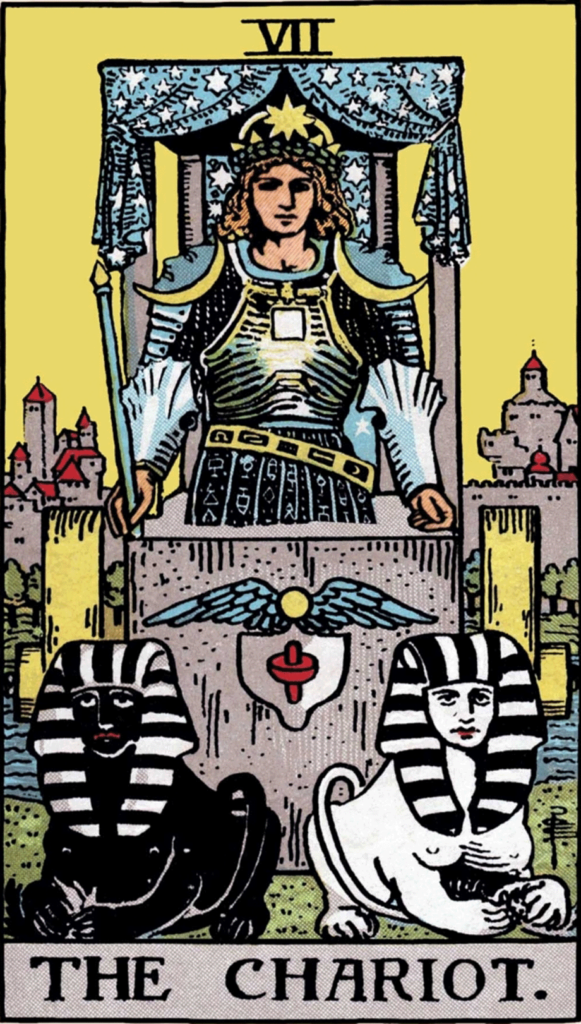
The card depicts an armored figure in a canopied chariot, apparently pulled by a black and a white sphinx. The figure has a crown and scepter. The crown is topped with an eight-pointed star. The canopy above his head is blue with five, six, and eight pointed stars on it. Beneath the crown he wears the laurel of victory. The pauldrons (shoulder plates) on his armor are lunar faces, his vambraces (lower arms) look like the shells of a marine creature. On his breastplate is a white square. He wears a belt with numerous symbols engraved on it, and his tasset (kilt) is likewise covered with symbols or glyphs. On the front of the chariot is a winged disk, overtopping a shield with a spindle or top. Two yellow or gold wheels are at the side. Behind the chariot is a river or moat, and behind that a stand of trees, behind which is a walled city. The sky here is yellow.
The conventional read on this card is triumph or victory, and control. This meaning is echoed in the Minor Arcana six of wands, just as the Lovers may be echoed by the two of cups. In these instances, I often read the minors as involving real world occurrences, such as winning a legal suit, or passing a test, or in the literal sense, victory in battle. The Major Arcana I tend to regard as symbolic of the grander cosmic forces that pervade the universe, whose influences are far more subtle and long reaching. And for the Chariot, I divine Cosmic Force itself.
Let me explore that a bit. Gravity is a force. Electromagnetism is a force. There are strong and weak nuclear forces that bind together the tiniest of things, just as the other forces bind together the massive and cosmic. Gravity either shapes space and time, or is the consequence of that shape. These forces are the wheels upon which the whole of existence turns. So in the Chariot I find some parallels to read it in terms of “Force of Nature” rather than simple personal victory in conflict.
It is true that the Chariot is an engine of war. It is among the first, if not the first. In its day it was the equivalent of a fighter jet, and as such, equally had no other use. These were multi-terrain high speed weapons platforms. They had no seats, no place to carry cargo. Their payload was a driver and possibly an archer or lancer. On the battlefield they were a terror, but they tended to fall out of use towards the middle of Roman empire. Mounted cavalry was typically more mobile, particularly away from roads and open planes, and warfare had moved to a paradigm of siege and counter-siege.
Ironically the man in the Chariot stands before the very thing that contributed to the end of chariot warfare, the walled city. Castles, fortifications, and barriers such as moats and trenches meant that troops primarily clashed face to face after a long series of bombardments from a distance had destroyed both defenses and the resolve of the defenders. The Chariot visually represents an anachronism. Its military value is minimal in the environs it occupies, therefore it may only be viewed as symbolic. It is an emblem of victory, of dominion, rather than the thing itself.
When I look at this card I am always reminded of the Fortune Teller Booth so prevalent in old arcades and carnivals. The man is inside a box with the roof. He looks suitably exotic, but if we observe closely he’s not whole. His body ends on top if the box. His hand rests upon it. There is no interior where a person stands, this is all for show, all to entice us to believe in the promise and wonder it appears to represent. This chariot in fact, looks to me like a block of stone, on top of which a mannequin of the rider has been bolted. And, in fact, the wheels don’t really touch the ground (see image below), so what are we to make of that? The sphinxes are not engaged in pulling the Chariot forward either, so that just adds to the idea that this is some sort of display rather than a working mechanism. Perhaps the Unstoppable Force is actually the Immovable Object?
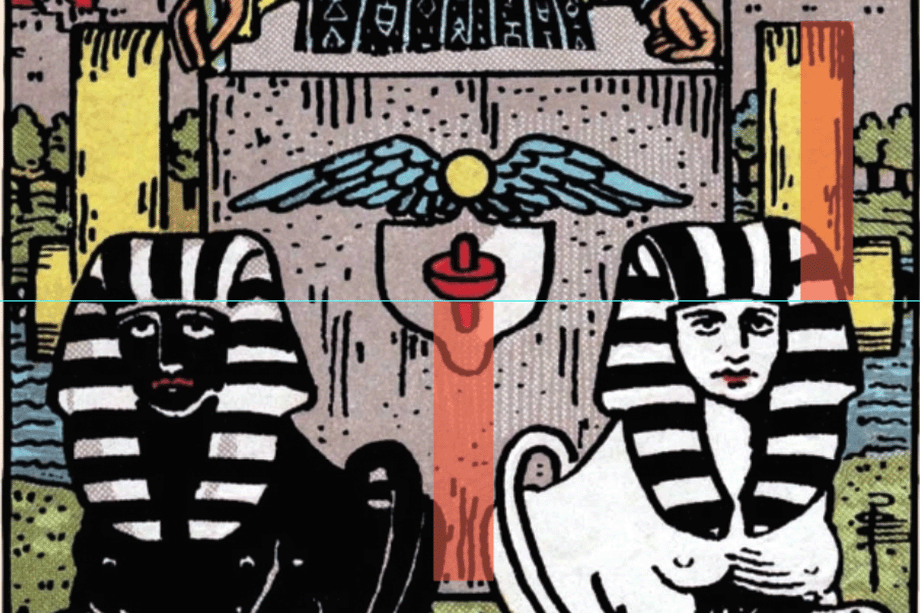
I positioned a guide line in the center of the wheel hubs. (That’s the light blue line running across just over the sphinxes brows). I created a rectangle that ran from that line up to the top of the wheel. I then copied that rectangle and moved it below the line, and then slid it over to where the bottom of the Chariot is visible between the sphinxes. As you can see, the rectangle, which represents accurately the size of the bottom half of the wheel, is not long enough to reach below the bottom of the car. At best, this Chariot is going to be dragging.
This may have been an accidental consequence of covering up the wheels with the sphinxes. On the earlier Marseille Tarot the wheels are shown jutting out to the sides, rather than frontal. That Chariot also would not move in that configuration, though I think that is more a medieval convention to show them as wheels, much like the shedu of Babylon have five legs, if viewed from a particular point.
It should not be surprising that we are confronted with this contradiction in yet another Tarot trump. The presence of the black and white and male and female sphinxes inform us that we are again needing to think in terms of the Doctrine of Opposite Extremes. They share the same esoteric DNA as the Lovers and the captive souls on XV, and they embody the two pillars of the Priestess. We are dealing again with that which is fixed and that which is changeable, and the Chariot sits between them – both an Unstoppable Force and an Immovable Object.
It is that dominion over the opposing factors that is invested in the person of the charioteer. Yet the card is not named the Charioteer. The person who is in that position is immaterial. They could be anyone. Waite’s description references a “king” and a “princely figure” but goes on to describe the rider as one not hereditarily royal and not part of the priesthood. His interpretation paints the occupant of the Chariot as one who achieves by conquest – Julius Caesar not Augustus. and further confines him to an almost sterile intellectualism. He cannot, according to Waite, understand the spiritual or sacred within himself, nor leap beyond the purely rational view of the world.
But a Chariot with wheels that don’t touch the ground is itself irrational. We may suppose that this is an artistic mistake (though an unlikely one) and the hidden bottom half of the wheels should be correct. We don’t know the timetable Smith was operating within, and some cards may have been executed under tighter deadlines. But the fact is that they don’t touch the ground, making the Chariot a rather elaborate Kiosk. Whether this was intentional or not it gives the reader a means to access that other part of the image, that which flows from our imagination and speculation, and gives us the electricity of insight when the card is dropped between others that do not make rational sense.
I mentioned earlier cosmic forces like gravity and electromagnetism as being connected with the Chariot. Consider that the effect of gravity does not have to move. It is everywhere and always, and yet still exerts itself in the same fashion. By this means we can begin to comprehend how the Chariot can represent force and energy, while at the same time, being fixed in its place. If its place is everywhere, then it doesn’t matter where the center is. The center is, in fact, everywhere and no where. Like the spinning top on the shield in the center of the cart, it moves within its own defined perspectives. The edges go round and round and round, even if the spindle is in a different place.
We can apply this idea to the dominion over forces in a much broader sense than Waite has. The Chariot can represent that Nothing that is Everything that is a feature of some Buddhist thinking, The Chariot establishes it’s own frame of reference, and imposes that frame of reference on what it comes into contact with. Looking at it from outside that frame of reference results in an incomplete, or skewed vision of what the thing actually is.
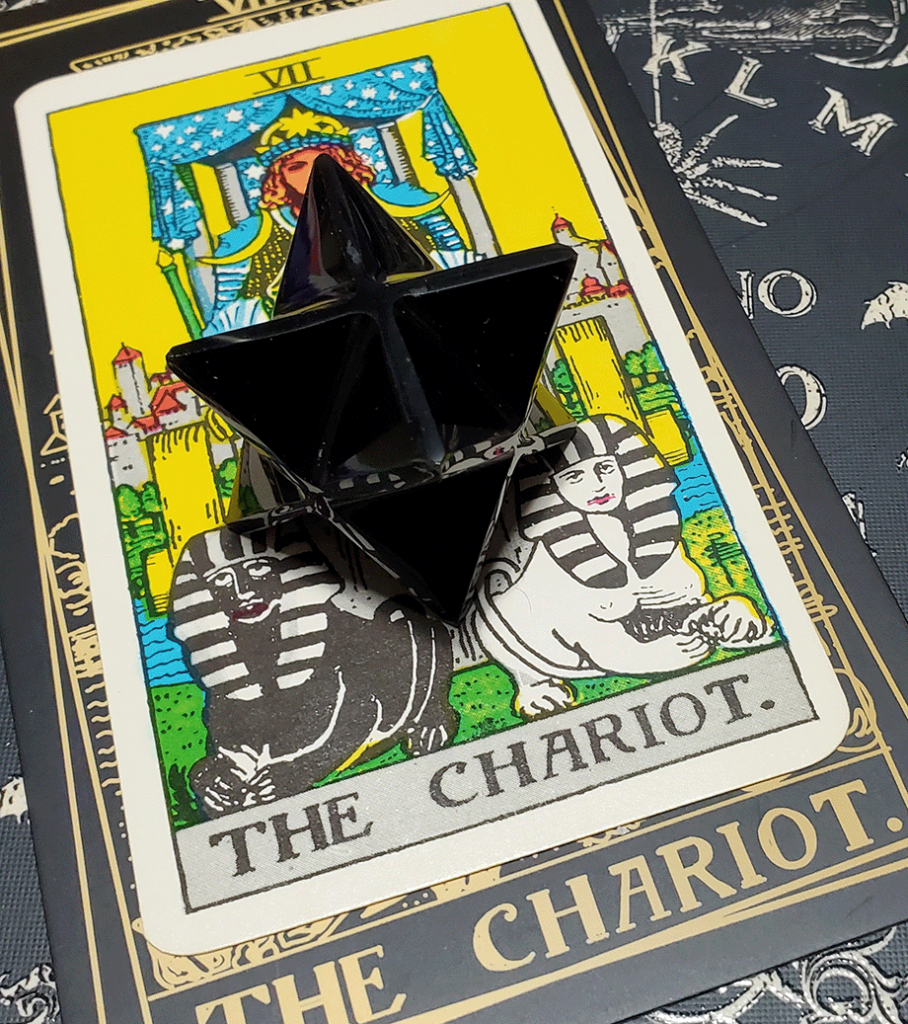
The shiny blackness of the stone makes photographing the object effectively difficult, so demonstrating its odd character in two-dimensions may be a futile attempt. I encourage you to look for these at your favorite stone or crystal shop. They seem to be becoming more prevalent.
It’s intriguing that the shape of the merkaba is frequently associated with the Chariot. A merkaba, as I have discussed earlier, is a three-dimensional representation of the two joined triangles of the hexagram. It consists of two pyramid objects – each pyramid having four three sided faces, that are merged into each other such that the points of each pyramid pierce the sides of the other. Drawing it in two dimensions is generally easy, but it’s difficult to conceptualize how that translates into actual space. I recently obtained one in my favorite black Mayan obsidian to better understand how something so theoretically simple can yield such a complex object.
If one turns the merkaba this way and that, the external shape changes. The outline remains a six pointed star, but the surfaces presented to the viewer are very different. Merkaba is supposed to derive from ancient Egyptian or Hebrew for Chariot, and this fascinating little shape with its many changing surfaces could certainly remind one of a tumbling or turning wheel. Perhaps it brought to mind the actions of the chariots as they wheeled and spun on the field of battle. But this is a good way of expressing my statement about the Chariot being a thing unto itself, defining it’s space and dimension in it’s own way, fluidly, depending upon where the observer encounters it.
This is the principle that Einstein called relativity, and that later was elaborated on to give us a quantum universe where the actual nature of things is entirely dependent upon when and how they are observed. In the quantum universe a thing is only what it is, once what it might be becomes fixed by the act of observing or recording it. We are again dealing with That Which is Fixed, and That Which is Changeable. The Chariot can be both a thing that moves forward constantly and a thing that doesn’t move at all. It truly depends on where we see it from.
If quantum mechanics is not your bag, I fully understand. It sounds far more like magic than it does science, and frankly I think it’s on the path to where it intersects with magic and we can finally get substantive things done without arguing over definitions. It’s not about how it works, because it works. The scribbled glyphs in a grimoire differ very little in appearance from the complex calculus of a physics equation, and to the outsider both are equally arcane and inscrutable.
Such glyphs are incorporated into the armor of the charioteer. The scribbles might easily have been added for texture, like the various glued-one model bits that adorn a science-fiction spacecraft. But if you look closely, these are known magical and alchemical symbols. I do not say that they give us the secret to the Philosopher’s Stone, but that their intentionally being included is to remind us that such formulae are part of our approach to the dominion over the forces of the cosmos. The armor of the charioteer is full of symbolism, but it is a surface only. The method and the means are not the meat.
Waite’s description in his very thin little booklet describes a character that is different from what Pamela Colman Smith has executed. It is likely he worked this from his notes or notes given to her that didn’t find full fruition, but the lunar symbols on his shoulders were, according to Waite, meant to be Odin’s ravens, or rather the Thought and Memory they symbolize. His scepter was meant to be a drawn sword, making the whole more martial, and possibly more active than this rather sedate hero is his box with the resting sphinxes.
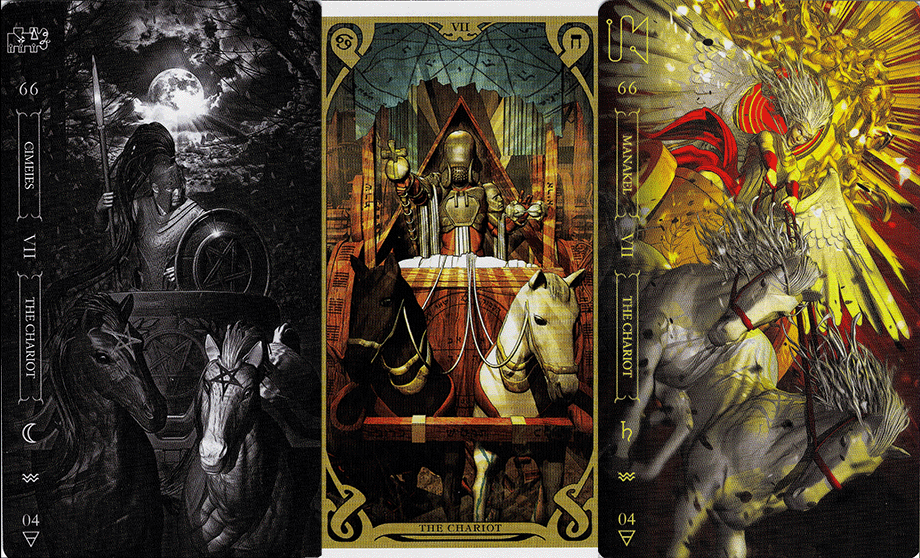
These latter decks although beautifully drawn from Fabio’s imagination, are bound by very strict adherence to the Kabbala and the hierarchies of demons and angels described in that manual. They include the seal of each being, the Kabbalistic number associated with it, it’s name, the Tarot number and name so that the deck may be used in the traditional sense, and then planetary and elemental signs, as well as an associated minor arcana card.
Keeping with tradition, the demon is on the left and the angel on the right. Note that they share the same element and minor card. In magical work they would be considered to naturally oppose one another.
Bear in mind that in addition to the use of these cards for divination, folk spell craft, and the complex Solomonic magic here, the Italian publisher Lo Scarabeo is also printing these exquistie decks for people who still simply play tarocchi with them.
It’s impossible to really know the dynamic between illustrator and author on these cards. Since the art has been the de-facto imagery, at least in the West, for Tarot for almost a century, comparison to what appears to be a pamphlet of text will always seem a bit inadequate. More has been written by many hands interpreting the images than analyzing Waite’s text. His Pictorial Key is written in that typical Victorian method of critical dismissal, where he spends more time discrediting or disallowing, the theories of his predecessors than to establish a legitimate basis for his own theories. I hope that I am not doing that, but it becomes inevitable if one is working on anything other than a parroting of previous interpretations.
I have tried to focus on my own impressions of the cards, drawn from my reactions to their visual content over fifty years of working with them. Of course, that reaction changes with my own age and experience, exposure to the ideas and theories of others, and the awareness of interpretations of the ideas and the artwork by the hands of other artists, sometimes including myself. In doing that, one can run afoul of the tendency to gainsay what other sources may have held. I hope that my approach has been fair, and used these sources as a comparison against which my own view may be measured, rather than as an outright disagreement.
Well, in some cases I do disagree. It is up to the individual reader to make of this what they will. If you find my observations have merit, then by all means employ them. I am not charging a royalty. On the other hand, if you find them of no value at all, there is nothing I can do to force you to use them. Unfortunately, I can’t give you back the time you spent reading this article, so I hope you find at least some value in it.
I will return next week with Card VIII, which in the RWS is Strength. Other decks have this card as Justice, and depending on which deck they switch between VIII and XI. As we have been using the RWS artwork as the basis for our little esoteric safari, we’ll preserve that order. I hope you will join me next week. Thank you again for your continued support.







